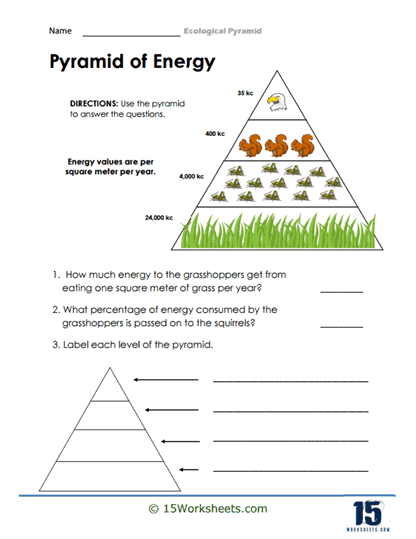Evaluating Pyramids

Worksheet Description
This worksheet introduces students to the concept of energy flow in an ecosystem, specifically detailing the energy values at each trophic level per square meter annually. Displaying an energy pyramid, it provides energy values for grass, grasshoppers, and squirrels, representing producers, primary consumers, and secondary consumers, respectively. Students are tasked with determining the amount of energy transferred between these levels, using the given energy values. Through a set of questions, they are directed to deduce the energy consumed by grasshoppers from the grass and the percentage of energy passed on to the squirrels.
To tackle this worksheet effectively, students should begin by closely observing the provided energy values for each trophic level. By comparing the energy at one level to the next, they can calculate the percentage of energy transferred. For instance, to find out how much energy grasshoppers derive from grass, they’d refer to the respective energy values. Subsequently, they can compute the energy percentage passed on to squirrels by comparing the energy values of grasshoppers and squirrels.
The primary objective of this worksheet is to teach students about the dynamics of energy transfer within an ecosystem, emphasizing the principle that significant energy is lost at each trophic level. It strives to instill an understanding of how only a fraction of the consumed energy is utilized and passed on to the next level. By providing numerical values, the worksheet allows students to quantitatively analyze and visualize these energy dynamics, fostering a deeper grasp of ecological principles. Through hands-on calculations and labeling tasks, students not only learn theoretical concepts but also hone their analytical skills.
You are given a pyramid that includes plants (grass), grasshoppers, squirrels, and eagles. You are asked a series of questions based on this including:
How much energy do the grasshoppers get from eating one square meter of grass per year?
What percentage of energy consumed by the grasshoppers is passed on to the squirrels?
